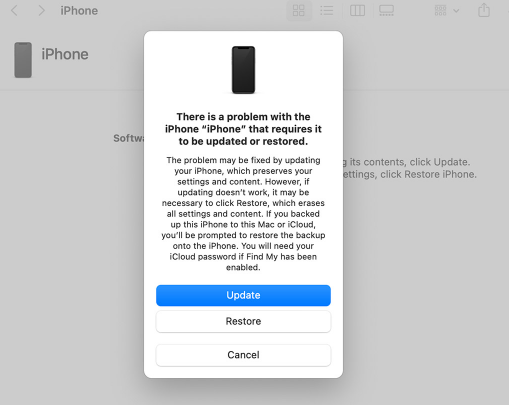Troubleshoot Common iPhone Issues using Recovery Mode
Recovery Mode explained (Full list of issues you can fix using it)
Recovery Mode is effective for troubleshooting iPhone issues/errors by updating iOS, restoring the device, wiping the data, etc. In this article. We will discuss how to enter Recovery Mode and what issues can be fixed using the recovery mode.

iPhone recovery mode can be used to fix your iPhone if it is stuck on an Apple logo screen, displays iTunes error messages, has a non-working touchscreen, won’t turn on or off, has Wi-Fi and Bluetooth issues, or suffering from any software issue.
How to Put an iPhone Into Recovery Mode
To troubleshoot any iPhone errors, first, you need to know how to access recovery mode. For this process, you need a PC with iTunes installed on it, a lightning cable, and your iPhone. Follow the steps below to perform the process.
Pre-requisite: Windows/Mac and iTunes must be updated to the latest versions.
- Open Finder if you are using Mac having MacOS Catilina or later.
- Open iTunes if you are using Windows or Mac with MacOS Mojave or earlier.
- If iTunes/Finder is already running on your PC, relaunch it after closing.
- Once you’ve set it up, now enter the recovery mode by applying the following key combinations.
iPhone 8 and later:
Press and release the volume up button.
Press and release the volume down button.
Press and hold the side button until the recovery mode screen appears.
iPhone 7:
Press and hold the volume down button and side button until the recovery mode screen appears.
iPhone 6 and earlier:
Press and hold the Home button and side/top button until the recovery mode screen appears.
Now your iPhone is in recovery mode. You can see the Restore and Update options on your iTunes/Finder screen. You can utilize either of the options depending on your requirement.

If you want to erase the device, go for the Restore option. If you intend to just update the iOS for better performance, without losing data, you should select the Update option. The update will start downloading, which you can also see on your PC screen, and your phone restart after the update is completed.
Common issues that can be fixed using iPhone Recovery Mode
Now that you know how to enter recovery mode, you can fix your iPhone issues without expert help. This simple yet highly effective method has helped many users to get their devices back to normal functioning. A list of different errors/issues is mentioned below, you can see in which way you can utilize the recovery mode to your advantage.
1. Stuck on Apple Logo Screen
Sometimes, an iPhone may become stuck on the Apple logo screen during startup. This can be caused by something as simple as a misbehaving app or as complex as outdated software. If your iPhone is stuck on the Apple logo, you can enter Recovery Mode and reinstall the iOS software to fix the issue.

2. iTunes Error Messages
iTunes error messages are pop-up alerts indicating something has gone wrong while using iTunes. These errors can occur in many cases, such as when attempting to connect an iOS device to a computer running the latest version of iTunes or trying to update or restore the device. In some situations, these errors may be caused by an issue with the device’s software or hardware.
The iTunes error messages can be resolved by entering recovery mode. Once in recovery mode, the user will have access to more options than when trying to troubleshoot the issue in iTunes.
These options may include restoring to an earlier version of iOS, updating and reinstalling iTunes, or attempting a DFU restore. Depending on the specific error message given, different steps will need to be taken to get the device running again.

3. Touch Screen Not Working
In many cases, an iPhone’s touchscreen may stop working and become unresponsive. This can be a frustrating problem, as, without the touchscreen, it is impossible to access any of the device’s features or settings. One of the probable causes of this issue is a software error that has caused the operating system to crash or become corrupted. To fix this problem, put your device in recovery mode and perform a system Restore.
This will erase all data from the device and reinstall the operating system, which will fix any software issues and allow the touchscreen to once again become responsive.
4. iPhone Not Turning On/Off
When it comes to Apple devices, one of the most common problems people experience is their iPhone not turning On or Off. This can be due to software malfunctions. If your iPhone is not responding when you try to turn it on or off, there are a few steps you can take to troubleshoot the problem and revive your device.
The first step is to force restart your device. This is done by pressing and holding the power button until you see the Apple logo. If this doesn’t work, try a recovery mode Restore. In recovery mode, iTunes will detect a problem with your iPhone and allow you to fix it without losing any of your data.

5. Wi-Fi & Bluetooth Issues
As iPhones age, they can experience many technical issues, including Wi-Fi and Bluetooth connectivity problems. This can be due to outdated software, corrupted files, or a variety of other reasons. When the Wi-Fi or Bluetooth on an iPhone stops working correctly, you can try restarting the device. However, if the issue persists, you need to enter recovery mode to get the Wi-Fi & Bluetooth working again.
Final Thoughts
iPhone recovery mode is a useful tool for troubleshooting and resolving software issues with Apple devices. From reinstalling an earlier version of iOS to attempting a DFU restore, many possible solutions can be used to solve various iPhone problems.
It’s important to remember that while entering recovery mode can fix some major issues with your device, it may not always be the best solution for every problem.
By following the steps outlined in this guide, you will have a better understanding of how recovery mode works and when is it appropriate to use. With this knowledge, you can confidently tackle any issue with your iPhone without hesitation.





